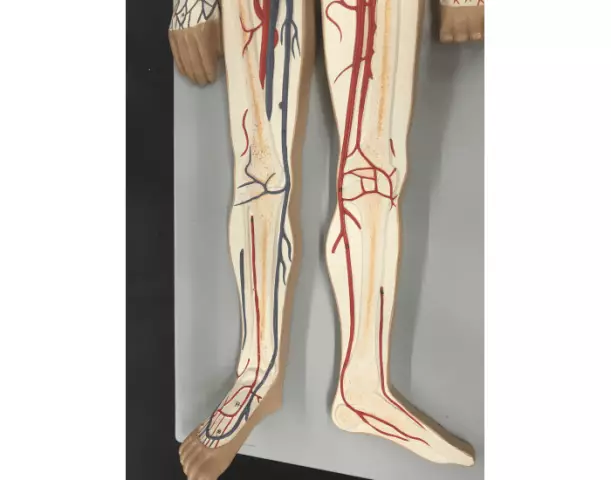- Author Rachel Wainwright [email protected].
- Public 2023-12-15 07:39.
- Last modified 2025-11-02 20:14.
Dissociative Disorders
The content of the article:
- Causes and risk factors
- Forms of the disease
- Symptoms
- Diagnostics
- Treatment
- Possible complications and consequences
- Forecast
Dissociative disorders are a group of mental disorders characterized by impaired memory, consciousness, and a sense of personal identity. Normally, all these mental functions are integrated into consciousness. Upon dissociation, some of them separate from the community and become independent.
The first description of dissociation was made by the French physician and psychologist P. Janet at the end of the 19th century. He noted that in certain cases there is a splitting off from the main personality of a complex of ideas that exists outside consciousness, independently, but is able to return to the whole consciousness with the help of hypnosis.

Dissociative disorder is a violation of a sense of personal identity
Causes and risk factors
Splitting (dissociation) is a special mechanism that allows the human mind to divide into several parts the thoughts and memories of ordinary consciousness. After the bifurcation, the formed parts of subconscious thoughts remain and can later emerge in consciousness under the influence of triggers (trigger mechanisms). These mechanisms include events and objects that surrounded the patient at the time of the traumatic event.
Factors predisposing to the formation of dissociative disorders are:
- prolonged severe stress;
- lack of care and love from adults in childhood;
- psychological, physical or sexual abuse;
- prolonged insomnia;
- overdose with nitrous oxide ("laughing gas");
- participation in hostilities;
- postponing a car accident or natural disaster;
- severe psychological conflicts;
- long-term severe somatic diseases;
- death of loved ones.
Forms of the disease
Depending on the predominance of certain symptoms in the clinical picture of the disease, dissociative disorders are divided into several forms:
- depersonalization;
- dissociative amnesia;
- dissociative fugue;
- dissociative identity disorder.
Symptoms
The clinical manifestations of each form of dissociative disorder are different from others.
With depersonalization, patients have the feeling that they are observing various mental and physical processes of their body from the side, like outside observers. This sensation can be both episodic and constant. Distortions in the perception of space and time are often noted. Derealization is also characteristic of the named state, that is, the feeling of unreality of the surrounding large world. This form is often accompanied by the formation of anxiety and depressive states.
Dissociative amnesia is a sudden loss of memory following a traumatic event or severe stress. Consciousness is not disturbed, criticism of one's condition and the ability to assimilate new information are preserved. This type of disorder most often occurs in young women during natural disasters or hostilities.

Sudden memory loss occurs with dissociative amnesia
In a dissociative fugue (dissociative flight response, psychogenic flight response), patients suddenly leave work or home. Consciousness is thus affectively narrowed. In the future, they have a complete or partial loss of memory for past life events; as a rule, there is no awareness of this loss. Sometimes the patient begins to consider himself a different person, as a result of which he behaves and speaks in a different way, responds to a different name and is not aware of the events taking place around him.
Dissociative identity disorder is characterized by the presence in the patient of two or more identities (personality states), different age, gender, nationality. Periodically, each of them begins to dominate, thereby determining the behavior, actions, views of the patient. Personalities change suddenly. During the dominance of one identity, the patient is not aware of the presence of other identities in his consciousness.
Another symptom of dissociative disorders is Ganser's syndrome, which is the deliberate production (reproduction) of a severe mental disorder. It is often associated with other psychiatric disorders (perception disorders, disorientation, amnesia) and is usually found in men in prison.
Diagnostics
The diagnosis of dissociative disorder is made if:
- two or more personality states (different identities);
- memory lapses, as a result of which the patient forgets important personal information.
In order to exclude organic lesions of the central nervous system, computed or magnetic resonance imaging, electroencephalography are recommended.

MRI allows to exclude lesions of the central nervous system, which can be confused with dissociative disorders
Dissociative disorders require differential diagnosis with the following diseases (conditions):
- temporal lobe epilepsy;
- infectious or tumor lesions of the temporal lobe of the brain;
- post-traumatic (post-concussion) amnesia;
- amnestic syndrome;
- mental retardation;
- schizophrenia;
- dementia;
- bipolar disorder;
- simulation.
Treatment
Treatment for dissociative disorders includes psychotherapy and medication. Hypnosis has a good therapeutic effect, allowing patients to get rid of painful, depressing memories and ideas. In some cases, hypnosis allows you to “close” alternative personalities.

Hypnosis is sometimes used to treat dissociative disorder.
Possible complications and consequences
Complications of dissociative disorder can include:
- increased anxiety;
- depression;
- drug addiction, alcoholism;
- sleep disorders;
- sexual dysfunction;
- suicidal attempts;
- persistent headaches.
Forecast
The prognosis for dissociative disorder is largely determined by the form of pathology. With a dissociative fugue, therapy can quickly normalize the patient's condition. The manifestations of dissociative amnesia also stop quite quickly, but in some patients this mental disorder becomes chronic. Dissociative identity disorder and depersonalization are the most resistant to therapy. They usually acquire a chronic course, and a course of treatment of at least five years is required to achieve a stable remission.
YouTube video related to the article:

Elena Minkina Doctor anesthesiologist-resuscitator About the author
Education: graduated from the Tashkent State Medical Institute, specializing in general medicine in 1991. Repeatedly passed refresher courses.
Work experience: anesthesiologist-resuscitator of the city maternity complex, resuscitator of the hemodialysis department.
The information is generalized and provided for informational purposes only. At the first sign of illness, see your doctor. Self-medication is hazardous to health!






